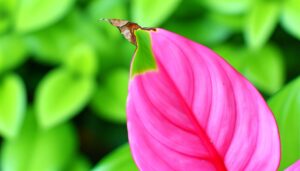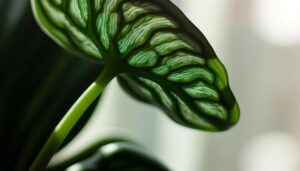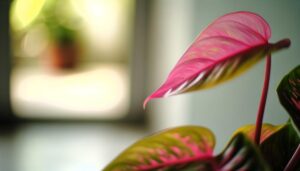What Is the Price of a Philodendron Erubescens in the Philippines?
The prices of a Philodendron Erubescens in the Philippines range from ₱429.00 to ₱1,050.00, depending on the source and size of the plant.
Philodendron Erubescens Price Comparison in the Philippines
| Source | Price | Description |
|---|---|---|
| Lazada PH | ₱429.00 | Full plant |
| Carousell PH | ₱1,050.00 | Blushing Philodendron Erubescens |
| Shopee PH | ₱577.00 | 2 to 4 inches cutting with sprout |
| Unbeleafable PH | Start at ₱199.00 | Philodendron Bundle |
| Shopleaf Plant Studio | ₱1,200.00 | Philodendron Imperial Green (M) in Nursery Pot |
Please note that prices may vary depending on the specific product, size, and shipping details.
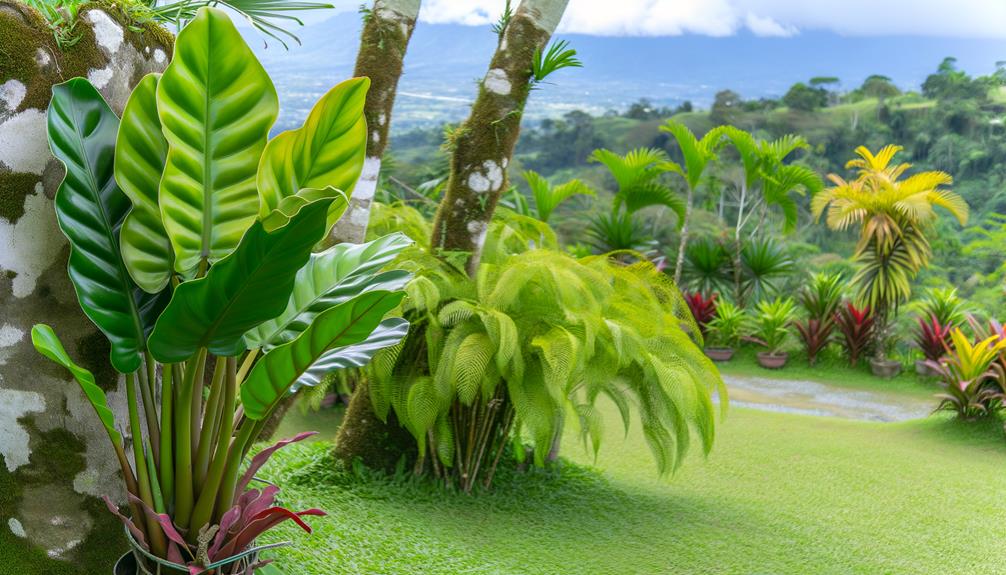
Current Market Trends
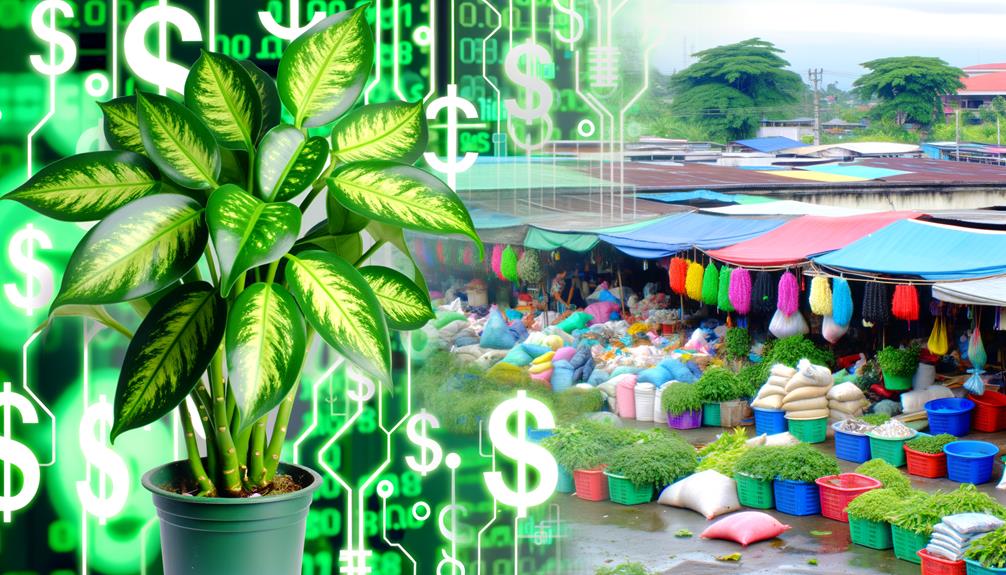
In the current market, the price of Philodendron erubescens in the Philippines exhibits significant variability due to factors such as plant maturity, coloration, and rarity of specific cultivars.
Mature specimens command higher prices due to their established growth and resilience. For instance, Philodendron erubescens ‘Pink Princess‘, known for its distinctive variegated pink leaves, tends to be more expensive than its less colorful counterparts.
Additionally, cultivars exhibiting rare phenotypic traits or unique variegation patterns are often priced at a premium. Understanding these market dynamics is essential for both buyers and sellers in determining fair valuation.
The interplay of these factors highlights the complexity of pricing within the horticultural market for Philodendron erubescens in the region.
Regional Price Variations
The pricing of Philodendron erubescens exhibits substantial variability across different regions of the Philippines, influenced by factors such as local demand and supply dynamics.
In Metro Manila, the commercial hub, prices are generally higher compared to provincial areas due to elevated operational costs and consumer purchasing power.
Additionally, online marketplaces present a unique cost structure, often incorporating shipping fees that further affect the final price point for this sought-after ornamental plant.
Metro Manila Rates
Metro Manila, the bustling capital region of the Philippines, exhibits significant price variations for Philodendron erubescens due to factors such as demand, availability, and vendor reputation. Prices for this species, known for its striking red stems and dark green foliage, range from PHP 500 to PHP 3,000 per plant.
High-end nurseries and specialized botanical shops often command premium prices, reflecting their curated selection and plant health. Markets and street vendors may offer more competitive rates but with varying quality. Seasonal fluctuations also impact pricing; during peak demand periods, such as holidays and plant fairs, prices tend to surge.
Additionally, established vendors with positive reputations often attract higher-paying clientele, further influencing market dynamics within Metro Manila.
Provincial Price Differences
Philodendron erubescens prices in provincial regions of the Philippines exhibit notable disparities influenced by factors such as local demand, transportation costs, and regional cultivation practices.
In regions like Cebu and Davao, prices are often lower due to the favorable local climate and established horticultural communities that facilitate large-scale cultivation of Philodendron erubescens.
Conversely, in more remote areas like Batanes, elevated transportation costs considerably inflate prices. Additionally, microclimatic conditions and soil quality variations impact the growth rates and health of the plants, further contributing to regional price differences.
Collectively, these factors create a complex pricing landscape, underscoring the importance of geographic considerations when evaluating the market for Philodendron erubescens in the Philippines.
Online Marketplace Costs
In addition to regional physical markets, online marketplaces offer a dynamic platform where Philodendron erubescens prices exhibit substantial regional variations, influenced by factors such as virtual demand fluctuations, seller competition, and digital logistics.
The diversity in pricing can be attributed to the availability of rare cultivars, shipping costs, and the seller’s location.
For instance, an online vendor in Metro Manila might price Philodendron erubescens at PHP 1,500 due to higher operational costs and demand, whereas a seller in a provincial area might offer the same plant for PHP 1,000.
Additionally, the platform’s reach affects price; popular e-commerce sites like Lazada and Shopee often reflect competitive pricing due to numerous sellers, while niche plant forums may exhibit higher prices for specialized varieties.
Online Vs. Local Stores
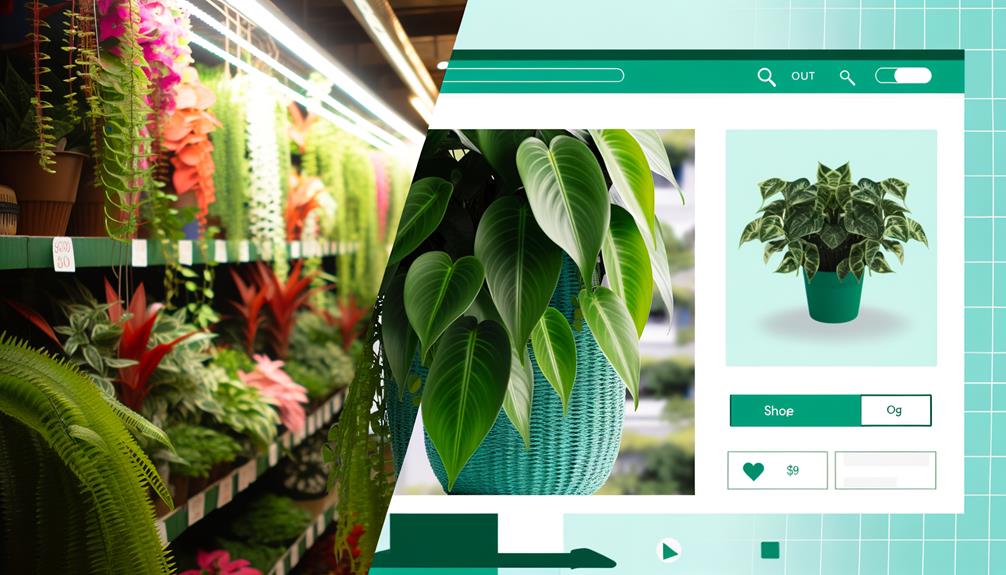
When comparing the cost of *Philodendron erubescens* between online platforms and local nurseries in the Philippines, several factors must be considered.
Online platforms often provide a wider selection, yet entail additional costs like shipping and potential phytosanitary certification. These fees can inflate the overall price.
Conversely, purchasing from local nurseries allows buyers to assess plant health directly, ensuring the specimen is free from pests and diseases. Additionally, local nurseries may offer personalized care advice and immediate access without shipping delays. However, the selection might be more limited, leading to potential price variations.
Ultimately, the choice between online and local purchasing depends on individual priorities regarding cost, convenience, and plant quality.
Size and Maturity
The price of Philodendron erubescens in the Philippines is notably influenced by the plant’s growth stages. Juvenile plants, characterized by smaller, less developed leaves and shorter stems, typically command lower prices compared to mature plants with fully developed, broad leaves and extensive root systems.
Consequently, price variations are closely aligned with the size and maturity of the Philodendron erubescens, reflecting the plant’s developmental complexity and aesthetic appeal.
Plant Growth Stages
Philodendron erubescens progresses through distinct ontogenetic stages, each characterized by specific morphological and physiological changes that influence its market value in the Philippines. Understanding these stages is essential for cultivators and buyers alike.
- Seedling Stage: Early development characterized by the emergence of juvenile leaves and initial root establishment.
- Juvenile Stage: Exhibits rapid vegetative growth with smaller, simpler leaf structures.
- Mature Stage: Features larger, more complex leaf morphology and potential for flowering, significantly increasing aesthetic value.
- Reproductive Stage: The plant reaches full maturity, capable of producing inflorescences, which enhances both its rarity and desirability.
These stages dictate not only the plant’s physical appearance but also its care requirements, thereby impacting its overall market positioning in the horticultural industry.
Price by Size
Understanding the distinct growth stages of Philodendron erubescens provides a foundation for evaluating how size and maturity influence market prices in the Philippines.
Juvenile specimens, characterized by smaller, less developed leaves, often range from PHP 500 to PHP 1,500. These younger plants exhibit rapid growth rates but lack the mature foliage that collectors prize.
Intermediate-sized plants, with partially developed leaves and a sturdier stem structure, can command prices between PHP 2,000 and PHP 5,000.
Mature specimens, displaying fully developed large leaves and robust growth, often exceed PHP 7,000, reaching up to PHP 15,000 or more.
The valuation is contingent on factors such as leaf size, stem thickness, and overall health, underscoring the significance of plant maturity in price determination.
Rarity and Unique Varieties
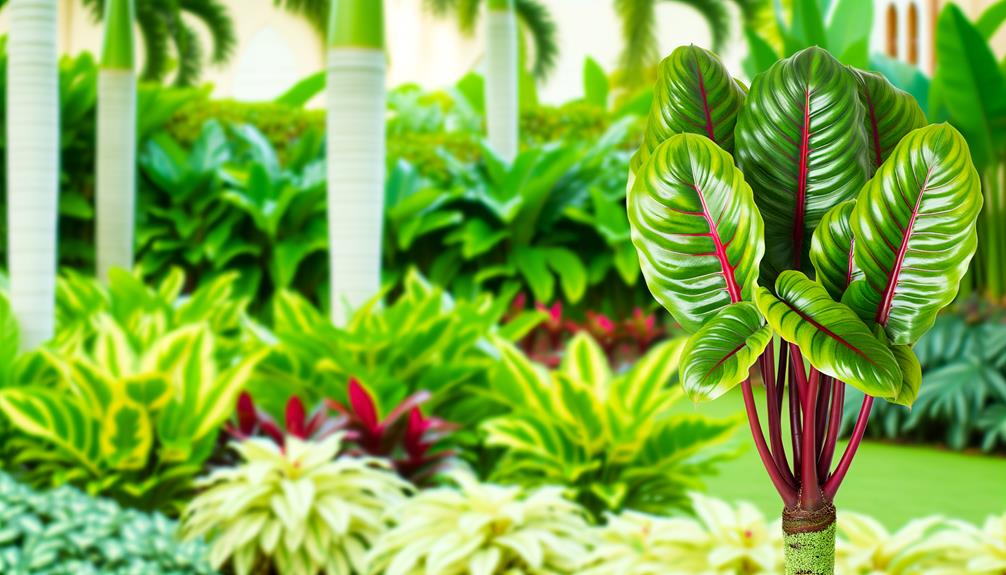
Given the diverse genetic lineage and limited availability of specific cultivars, Philodendron erubescens exhibits considerable variability, making certain unique varieties highly sought after by collectors. These unique varieties often feature distinct morphological traits and coloration that distinguish them from the more common types.
Below are some notable examples:
- Philodendron erubescens ‘Pink Princess’: Recognized for its striking pink variegation on dark green foliage.
- Philodendron erubescens ‘Red Emerald’: Known for its deep burgundy stems and vibrant red leaves.
- Philodendron erubescens ‘White Knight’: Features white variegation and green leaves, offering a stark contrast.
- Philodendron erubescens ‘Black Cardinal’: Characterized by its dark, almost black leaves that add a dramatic touch.
These rare varieties command higher prices due to their unique characteristics and limited availability.
Seasonal Price Fluctuations
Seasonal price fluctuations of Philodendron erubescens in the Philippines are greatly influenced by variations in supply and demand dynamics, regional disparities, and holiday market trends.
The availability of this species, often dictated by climatic conditions and propagation cycles, directly impacts pricing, with heightened demand during festive periods such as Christmas and Lunar New Year causing notable price surges.
Additionally, regional differences in cultivation practices and distribution networks contribute to localized pricing variations, further complicating the market landscape.
Supply and Demand Impact
Fluctuations in the price of Philodendron erubescens in the Philippines are greatly influenced by the interplay of supply and demand, which varies with seasonal changes. During the wet season, propagation rates increase, leading to a higher supply. Conversely, the dry season results in reduced growth rates, limiting availability and raising prices.
Key factors affecting supply and demand include:
- Seasonal Growth Rates: Enhanced during the wet season, constrained during the dry.
- Consumer Interests: Peaks during festive seasons and holidays.
- Propagation Success: Higher in favorable climatic conditions.
- Market Trends: Influenced by social media and gardening trends.
Understanding these dynamics is essential for predicting price variations and making informed purchasing decisions.
Regional Price Differences
Regional price differences for *Philodendron erubescens* often vary significantly due to the specific climatic conditions and local demand patterns across different areas of the Philippines.
In regions with ideal growth conditions, such as those with high humidity and consistent temperatures, the supply tends to be higher, reducing market prices. Conversely, in areas where environmental conditions are less favorable, scarcity drives prices upward.
Additionally, urban centers with higher population densities and greater disposable incomes generally exhibit elevated demand, further influencing pricing dynamics.
Seasonal variations also play a role, with prices typically rising during dry months when plant maintenance becomes more challenging.
These regional disparities highlight the intricate interplay between ecological factors and market economics in determining the cost of *Philodendron erubescens*.
Holiday Market Trends
During holiday seasons, the price of Philodendron erubescens in the Philippines often experiences notable fluctuations due to increased consumer demand and limited availability.
These price variations are influenced by several key factors:
- Increased Demand: Holidays such as Christmas and New Year drive up demand as these plants are popular gifts.
- Limited Supply: Nursery stock is often constrained during these peak periods, causing scarcity.
- Transport Costs: Elevated logistic expenses during holidays can also contribute to higher prices.
- Market Speculation: Sellers may increase prices in anticipation of higher consumer willingness to pay.
Understanding these market dynamics helps consumers and sellers navigate the seasonal price landscape of *Philodendron erubescens*, ensuring informed purchasing and selling decisions.
Seller Reputation

The reputation of a seller greatly influences the perceived value and trustworthiness of purchasing Philodendron erubescens in the Philippines. Esteemed sellers, often verified through customer reviews and horticultural community endorsements, tend to command higher prices.
This is because of their demonstrated expertise in cultivating healthy specimens of Philodendron erubescens, ensuring accurate botanical identification, and adhering to phytosanitary standards.
Buyers are more likely to invest in plants from reputable sources, confident in the authenticity and healthiness of the Philodendron erubescens (syn. Philodendron erubescens cv. ‘Red Emerald’).
As a result, seller reputation mitigates risks associated with misidentification, pest infestations, and suboptimal growth conditions. The seller’s credibility plays a crucial role in determining both market price and consumer satisfaction.
Import Vs. Local Growth
When evaluating the price of Philodendron erubescens in the Philippines, one must consider whether the plant is imported or locally grown, as this greatly affects cost and availability.
Imported Philodendron erubescens generally incur higher costs due to:
- Shipping and Handling: International transport fees, phytosanitary certifications, and packaging.
- Import Duties and Taxes: Tariffs imposed by customs authorities.
- Supply Chain Complexity: Multiple intermediaries can increase final pricing.
- Quality and Rarity: Imported variants might offer unique traits or cultivars not found locally.
Conversely, locally grown specimens benefit from reduced logistical expenditures and quicker market delivery.
The local cultivation of Philodendron erubescens, adapted to the Philippine climate, often ensures more sustainable and cost-effective options for enthusiasts and collectors.
Bulk Purchase Discounts
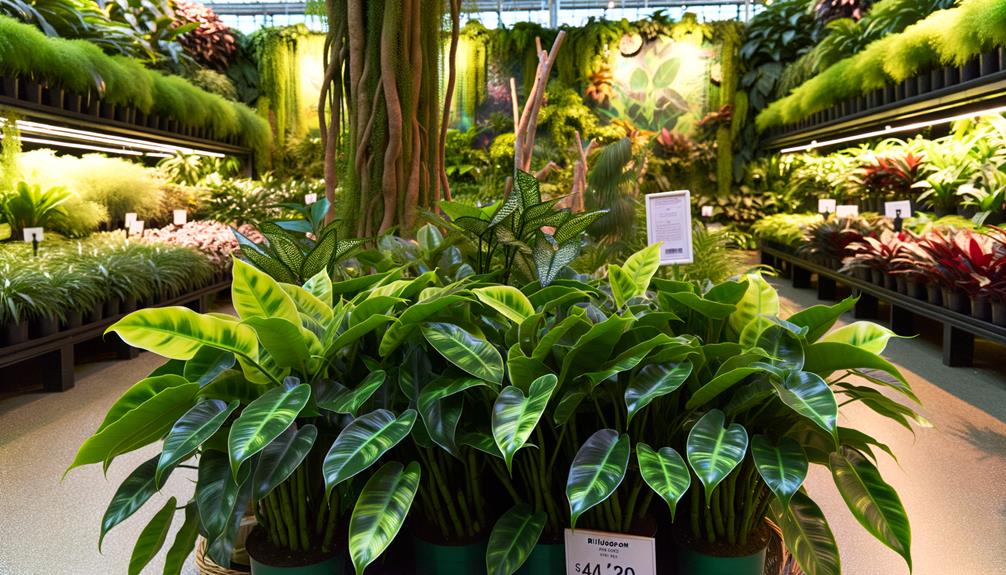
In addition to the considerations of import vs. local growth, bulk purchase discounts play a significant role in determining the overall cost efficiency for acquiring Philodendron erubescens in the Philippines.
These discounts are often offered by nurseries and wholesalers to incentivize larger orders, thereby reducing the per-unit cost of Philodendron erubescens, also known as the Red-leaf Philodendron. Typically, the price reduction is calculated on a sliding scale, where larger quantities yield more substantial discounts.
This economic advantage is beneficial for commercial landscapers, botanical gardens, and plant retailers who require a substantial number of plants.
Moreover, bulk purchasing can also mitigate logistical costs, such as shipping and handling, thereby enhancing the overall financial feasibility of large-scale acquisitions of Philodendron erubescens.
Care and Maintenance Costs
Proper maintenance and care of Philodendron erubescens, encompassing factors such as light, water, humidity, and soil conditions, are crucial to secure the plant’s top-notch growth and health.
The cost implications of these factors are as follows:
- Light: This species thrives under indirect sunlight, needing grow lights if natural light is insufficient, with expenses averaging PHP 1,000-2,000.
- Water: Regular watering is essential, but overwatering can lead to root rot. A moisture meter, priced around PHP 500, helps sustain ideal soil moisture.
- Humidity: Maintaining 60-80% humidity may require a humidifier, valued between PHP 2,000-4,000.
- Soil: Well-draining soil mixtures, specifically designed for aroids, typically cost PHP 300-600 per bag.
Understanding these expenses ensures excellent plant health and growth.
Budget-Friendly Alternatives
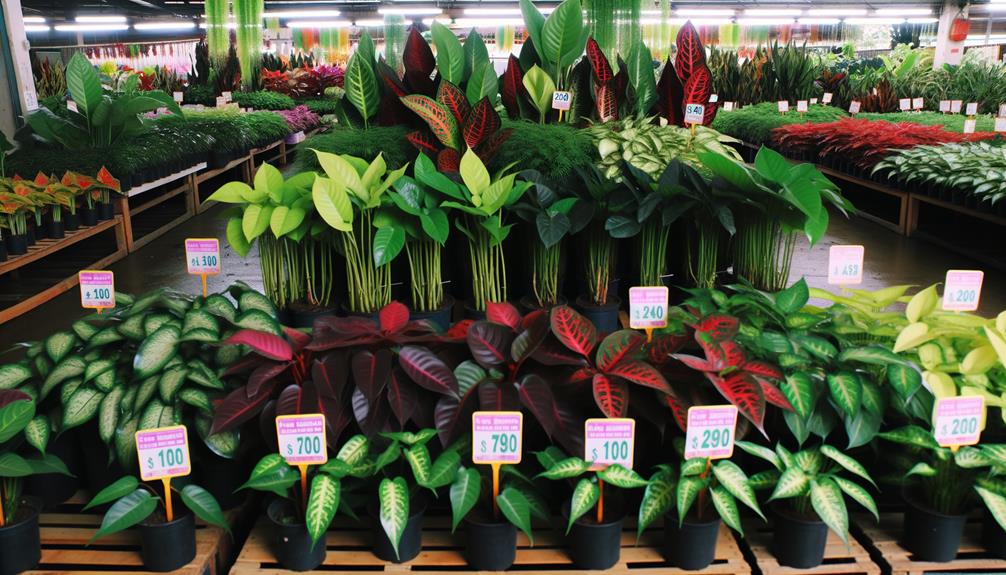
For cost-conscious philodendron enthusiasts, several budget-friendly alternatives can effectively support the growth and maintenance of Philodendron erubescens without compromising plant health. Substituting high-cost fertilizers with organic compost aids in nutrient provision while reducing expenses.
Utilizing perlite (Perlite) or vermiculite (Vermiculite) in place of expensive soil amendments can enhance aeration and water retention at a lower cost. Additionally, employing homemade insecticidal soap for pest control minimizes chemical expenditure.
Below is a comparison of budget-friendly alternatives:
| Alternative Material | High-Cost Equivalent |
|---|---|
| Organic Compost | Commercial Fertilizer |
| Perlite (Perlite) | Specialty Soil Mix |
| Vermiculite (Vermiculite) | High-End Soil Amendments |
| Homemade Insecticidal Soap | Commercial Pesticides |
Conclusion
In the Philippines, the price of Philodendron erubescens varies notably based on factors such as market trends, regional differences, and the plant’s size and maturity.
Noteworthy, a 2023 survey revealed that prices can range from PHP 500 to PHP 5,000, depending on these variables.
The increasing demand for rare and unique varieties, coupled with the cost of care and maintenance, also influences market prices.
Online platforms often offer more competitive rates compared to local stores.

